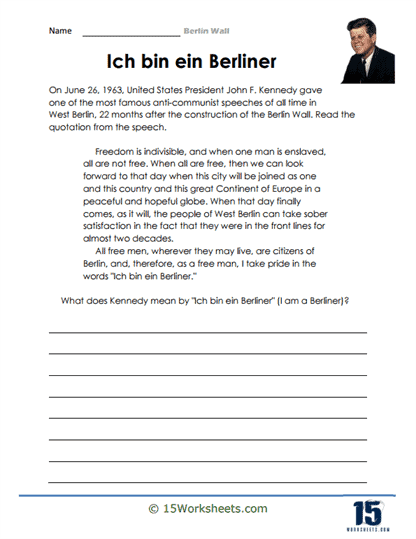Ich bin ein Berliner

Worksheet Description
This worksheet focuses on a renowned speech given by U.S. President John F. Kennedy in 1963, a pivotal moment during the Cold War era. It features an excerpt from the speech, emphasizing concepts of freedom, unity, and the symbolic importance of Berlin in the context of the Cold War. The core query of the worksheet challenges students to interpret and articulate what Kennedy meant by the phrase “Ich bin ein Berliner,” which translates to “I am a Berliner.” Accompanied by an image of Kennedy, this worksheet provides a snapshot of the President’s solidarity with the citizens of West Berlin amidst the political tensions of the time.
To effectively engage with this worksheet, students should first read the provided quotation thoroughly, noting the key themes and sentiments expressed by Kennedy. They should then delve into the historical context of the speech, understanding the significance of Berlin during the Cold War, and the construction of the Berlin Wall that preceded Kennedy’s address. Drawing from this background and the excerpt, students should critically analyze the meaning and implications of the statement “Ich bin ein Berliner.” Finally, they should craft a well-informed response that captures both the literal and symbolic connotations of the phrase, referencing the broader themes of the speech and its historical context.
The worksheet is designed to instill a nuanced understanding of a pivotal moment in Cold War history and its enduring significance. By dissecting one of the most iconic phrases from Kennedy’s address, students are encouraged to reflect on the power of rhetoric and the ways in which leaders convey solidarity and support in politically charged environments. The activity also pushes students to grasp the broader geopolitical stakes of the era, recognizing Berlin as a symbol of resistance against Communist encroachment. Furthermore, by diving deep into this singular moment, the worksheet fosters critical thinking skills, prompting students to analyze and interpret historical texts within their broader sociopolitical landscapes.
